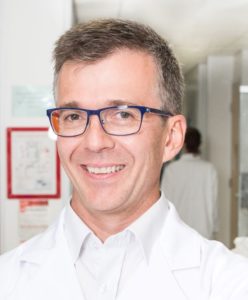Griffith University’s world-first study into cell transplantation to repair injuries to the nervous system has received a major boost thanks to a $5.4 million funding extension from the Motor Accident Insurance Commission (MAIC).

Professor James St John
Griffith’s Clem Jones Centre for Neurobiology and Stem Cell Research, headed by Professor James St John, is developing cell transplantation therapies to treat injuries of the nervous system.
Professor St John said spinal cord injury, peripheral nerve injuries and brain injuries are of particular concern for people who suffer road trauma and can leave victims with life-long paralysis and reduced quality of life.
“The research team has created a world-first cellular nerve bridge technology which has already received two major national awards, the NHMRC Marshall and Warren Innovation Award 2019 and the Research Australia Discovery Award 2020-2021,” he said.
“The innovative technology enables the rapid generation of cellular nerve bridges which can be easily handled by surgeons for transplantation to treat spinal cord injury.
“This latest round of funding will allow the research team to expand the nerve bridge technology to a wider range of nervous system injuries including peripheral nerve and brain injuries.
“We are now on the verge of a human Phase 1 clinical trial for treating chronic spinal cord injury, and through the ongoing support of MAIC we are delighted we have been able to deliver it right here in Queensland.”
The Clem Jones Centre team has successfully demonstrated the efficacy of the nerve bridges for treating spinal cord injury in preclinical models.
Professor James St John said the funding has enabled the team of more than 30 researchers to rapidly create, test and improve incredible technologies that were just a dream a few years ago.
“By combining discovery research with translational research, we can fast-track the delivery of therapies to the clinic,” Professor St John said.
“Our research team is successful because of the diversity of our ideas.
“Our team members come from 12 different countries, and we cover all areas of research from discovery cell biology, to bioengineering, surgery, rehabilitation and clinical trial planning.
“It also means we can simultaneously develop and translate the research into clinical outcomes.”
The new MAIC funding of $5.4 million brings the total MAIC investment into the therapy development to more than $16 million since 2017, with the major focus of the research being to develop a therapy for spinal cord injury.
Insurance Commissioner Neil Singleton said MAIC was delighted to continue to support Professor St John and his team in their potentially ground-breaking work.
“Road trauma remains one of the leading causes of both spinal cord and brain injuries which can have devastating impacts on the lives of everyday Queenslanders and their families,” Mr Singleton said.
‘Our continued support of this important research reflects our commitment to investing in initiatives which can make a real difference in mitigating the impacts of road trauma.
“We are excited about the opportunities that may emerge as this research proceeds to a clinical trial in the near future.”
The Clem Jones Centre for Neurobiology and Stem Cell Research was established in 2016 with funding from the Clem Jones Foundation ($2.4 million since 2016) with the aim of creating therapies to treat injuries and diseases of the nervous system.
The Centre is part of the Griffith Institute for Drug Discovery and the Menzies Health Institute Queensland, with the spinal cord project a legacy life-long project of the late Professor Emeritus Alan Mackay-Sim.
The Centre has also been strongly supported by the Perry Cross Spinal Research Foundation with more than $2 million in funding.


